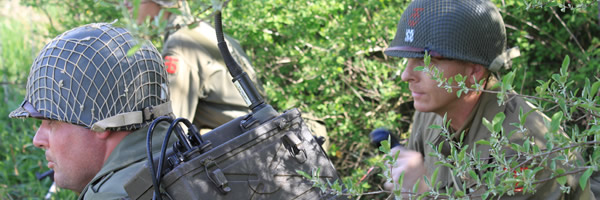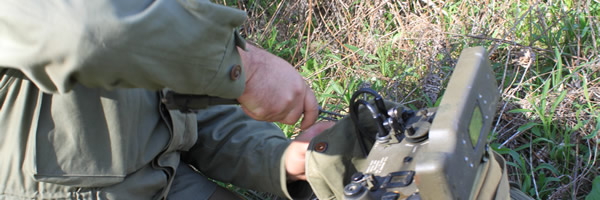Tableau Number 2
The SCR300 Radioman
Date: April 2013
Author: Pat Costa - 88th ID & 5th Rangers Dog Company
90th IDPG Editors - Chris Guska, Lee Mudd, Mike Ellis
Putting it together
SCR-300 Radioman Impression:
Based on photographic and anecdotal evidence, a basic radioman impression should have the following
SCR-300 Components & Accessories Radio BC-1000 Strap ST-50-A Harness ST-54-A Case CS-128 Belt ST-55-A Handset TS-15 Bag BG-150 Antenna AN-130 Antenna AN-131
Individual Equipment Weapon Ammunition Pouches Edged Weapon E-Tool First Aid Pouch Canteen Set
Usage Recommendations:
Having participated in a number of World War II reenactments as a radioman, a communications plan should be developed and disseminated for effective use of radios. The event coordinator should provide a Signal Operation Instruction briefing wherein the following responsibilities and concerns would be addressed:1. Assignment of a NCS (Net Control Station) who would take charge of managing and monitoring the net. This same person could also be in the field as a unit radio operator or he could be back at camp.
2. The radio net call word or words
3. The radio codenames for the units
4. A codename used to change frequencies if the NCS (or others as reported to the NCS) suspect enemy monitoring. The frequency could be pre-arranged. Codenames could be given to the different frequencies used in case the need to switch many times arises.
Radioman placement and location at an event:
The placement of a radioman at a World War II reenactment, as explained by Richard Killblane, a transportation historian for the US Army is,
“[W]ithin arm's reach of his commander. If the commander needed to talk to higher, then the [radioman] had better be right beside him or he goes back on the line and the CO [commanding officer] finds another [radioman].”
However, sometimes continual monitoring by the CO can be tiresome, so often what might occur is CO’s,
“…would have [a radioman] monitoring the company and battalion frequencies [and] just find a spot and talk to each other, then only bother [the CO] if battalion needed [the commander].” (2010, personal email correspondence)
In terms of unit location a, “SRC-300 was used at the company level, not platoon; it would be used at reenactments above company level [also]. Companies could talk laterally to each other and higher to battalion, if that HQ existed. Reports would include when contact is made. [CO’s] wanted to know [the] estimated size of enemy force, type of weapons and location (or direction) of the enemy. Radios [could be] used to call for fire (artillery) [if it existed at the event].” (Killblane, 2010 personal email correspondence)
Therefore, at reenactments one of two things could occur:First, each individual unit could have a radioman that would operate within the net to represent his unit. These radiomen could report and communicate with each other, with the only authority being the NCS.
Another option could be to combine units into companies and battalions and assign a radioman to each company and one to the battalion. In this manner, radiomen could communicate with each other but also take orders and submit reports from/to a higher authority (i.e. the battalion). The NCS would not issue any orders and like in the first method would only monitor the radio net.

Introduction
Section 1: By the book - TO&E
Section 2: Notes from the manuals on equipment
Section 3: Original Photographs - Key Observations
Section 4: Notes on Training and Use
Section 5: Putting it together- Modern Interpretation (you are here)
Section 6: Adapting the SCR300 for Reenactment Use
90th IDPG Original Research



